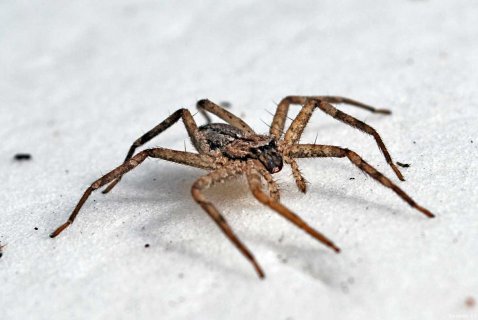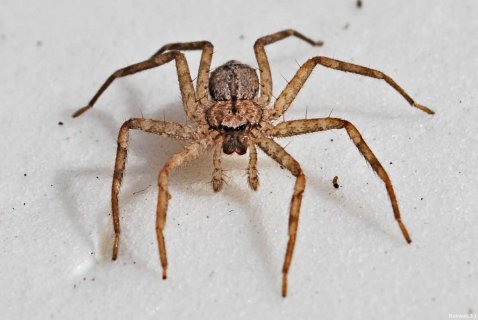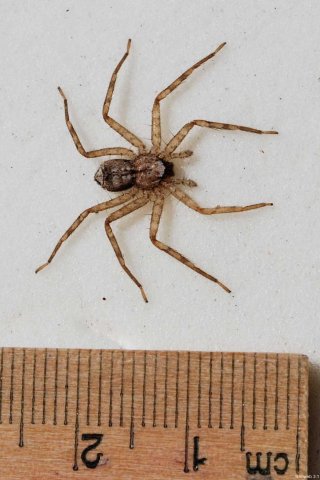If you’re a regular reader of this blog, you know by now that I love my pool fence. I’ve gotten more good bugs on my pool fence than I have from any other single source on the homestead. But every now and then I have to venture inside the fence for some reason or other, even when, as now, it’s no longer “swimming season” (defined as water temperature at or above 85°F).
Usually these excursions intramuros are to retrieve some object Eric has thrown over the fence and NEEDS to have back in his hot little hands. Now, daddy, now NOW NOW! A couple of weeks ago, it was his kickboard. So I dutifully went behind the fence and did my little reach-out-and-grab-for-it-without-falling-into-the-pool-and-isn’t-this-a-narrow-piece-of-deck-between-fence-and-water dance. And when I finally succeeded in fishing the kickboard out of the water, I found a curiously flattened (by nature, not by me) spider clinging to it:
I took a few photos of it and posted them to bugguide.net, and fairly shortly thereafter received word that it was a spider in the genus Selenops, family Selenopidae, commonly known as “the flatties.” As you know if you’ve read the first part of this miniseries on spiders, the eye arrangement is often critical to placing the spider even to the family level. And this family, as the etymological explanation on bugguide attests, is actually named after its eye arrangement:
Selenops is from Greek selene (σεληνη)- “moon” + ops (ωψ)- “eye, face”. Latreille translated it into French as “yeux en croissant” which means “eyes in a crescent.”
That’s right, this spider genus actually makes “moon eyes” at us! It wears a crescent moon on its face and in its binomial. Appropriate for an astronomer-turned-naturalist, no?
Now back to our spider.
Based on these photographs, this individual can only be identified to genus level; even with the fairly decent photos, it’s simply too difficult to ID some spiders any further. And in this case, no one on bug guide was willing to ID this spider beyond the genus level. There are seven known species in the US, and many more tropical ones that could easily be imported to south Florida. And without dissecting the genitalia under a microscope, there’s no way to be sure you’ve ID’ed it correctly.
Furthermore, taxonomic work on the genus is ongoing; a recent paper revised the North American, Central American, and Caribbean members extensively. That paper also describes them as superlative spiders:
They are exceptional in that both their running and striking speeds place them amongst the world’s fastest animals (Crews et al. 2008), and they are extremely dorsoventrally flattened.
Here are a couple more photos:
Face-on:
And dorsal, with ruler for scale:
The flattened aspect of the spider’s body obviously enables it to squeeze into smaller nooks and crannies than its more round-bodied brethren; beyond that, it makes it look über-cool. Despite their rather fearsome appearance, their fangs are too small and their venom too weak to pose much more than an annoyance to people.
So, hooray for the eyes of the moon!



